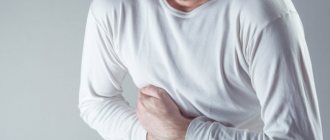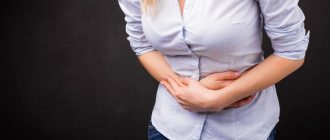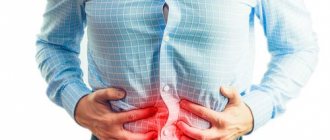We live in an imperfect world. People of all ages can experience heaviness and abdominal pain, which arise for various reasons - serious and not so serious. However, often a person, faced with a similar symptom, panics. Some, on the contrary, do not attach much importance and try to eliminate the discomfort with analgesics. Both of these seemingly simple solutions are not correct because they do not solve the problem. What to do if pain occurs in the intestines? First, you need to listen carefully to yourself and analyze the nature of the pain and the possible cause.
Turn on logic
In order not to panic right away, you should think logically: is this really pain in the intestines or is there a possibility of developing another disease of the gastrointestinal tract? If you are sure not, what could lead to intestinal pain? Maybe this is a reaction to dairy products? Or is it due to a long period of abstinence from food, the medication taken, or perhaps even a motor disorder? Having decided on these questions, it will be easier to understand what went wrong. However, this is only the first stage.
Distinctive features of intestinal disorders
In our abdominal cavity, in addition to the intestines, there are other organs. Ignorance of the anatomy of your own body can lead to a dead end in cases of abdominal pain.
An analysis of the nature of the pain will help clarify the situation a little. The reasons leading to this symptom are different and make themselves felt in different ways. Therefore, first, let’s define the property of pain that can manifest itself:
- contraction-like (trouble will strike suddenly and unexpectedly, then recede for an indefinite moment, then remind itself again),
- continuously.
Then try to understand the nature of the pain:
- pricking,
- cutting,
- pulling,
- aching,
- blunt,
- spicy.
Determine how intense the pain is: strong, moderate, weak.
After understanding these points, try to act by elimination.
The easiest way is to check whether the intestines are the cause of such troubles. To do this, after the bowel movement procedure, listen to your body: if the pain does not decrease, there is a problem in another organ.
Another sign of intestinal problems is a decrease in pain intensity when changing position. For example, lie down on your face with your knees pressed to your stomach. Did it help? With intestinal problems, the pain usually goes away, because in this case the pressure of gases and feces on the intestinal walls stops. In addition, gases can compress nearby organs, which most often is the direct cause of pain in the intestines.
If the painful sensations go away when a person assumes the fetal position, lying on his side, then there is reason to talk about problems with the pancreas. What other symptoms accompany inflammation of the pancreas, which is called pancreatitis, read this article.
The next difference between intestinal problems is the independence between pain and food intake. However, if the problem is in the transverse colon, located under the stomach, the situation will be different. A full stomach will put pressure on this intestine, causing pain.
Important! Don’t drag out the guessing game with your body. It is better to trust specialists, get tested and conduct additional examinations in a medical facility.
Secondary causes of pathology
Cutting pain in the abdomen does not always signal the presence of dangerous diseases. However, in any case, you need to be attentive to your body and its signals. Such symptoms may indicate various malfunctions in the body and non-serious pathologies. The main provoking factors for cutting sensations in the gastrointestinal tract:
Intestinal infection
If you have severe pain in the lower abdomen, which manifests itself against the background of nausea, diarrhea, vomiting, and elevated body temperature, you should consult a doctor. An intestinal infection can be dangerous. Pathology requires detailed research, therapeutic therapy and diet. Competent diagnosis is very important to help determine the type of causative agent of the disease. Knowing what caused the disease, the doctor will be able to prescribe the correct treatment.
Worms
When parasites enter the human body, serious problems occur in the functioning of the gastrointestinal tract. Helminths contribute to the fact that toxic substances poison the patient’s body. They actively grow, feed and reproduce. Symptoms of worms: diarrhea, pain in the abdominal area. When the parasites reach large sizes, the intestinal lumen noticeably narrows, resulting in severe pain, discomfort and increased gas formation. The brain and central nervous system suffer from parasites. For this reason, a person may experience headache, dizziness and weakness.
Cholecystitis
Inflammation of the gallbladder is accompanied by painful, cutting sensations. Most often, the cause of the disease is infection. Discomfort is observed in the right side. Unpleasant sensations appear several hours after eating food, especially fatty, spicy, fried and smoked food. Symptoms can make themselves felt against the background of stress and physical exertion.
Gynecology
Abdominal pain in women can signal an ectopic pregnancy or miscarriage. In the case of an ectopic pregnancy, the fertilized egg stops in the tube without reaching the uterus. As the embryo grows, stretching occurs and the tube may rupture. As a result of this phenomenon, the egg penetrates into the abdominal cavity, which is accompanied by excruciating pain. Most often, the tube does not rupture, as pain and bleeding force the woman to visit a doctor.
Follicular ovarian cyst
This disease is accompanied by pain in the lower abdomen. In each menstrual cycle, follicles mature, one of which will be needed for the egg to mature in it. When it ruptures, the egg leaves it. If this does not happen, the egg and follicle form a cyst that increases in size. There is profuse bleeding and intense painful syndrome.
Portrait of pain
It is not at all easy to figure out the reasons for the illness that has overtaken you.
A portrait of pain sensations will help to clarify the situation a little. They can be:
- Sharp cramping, localized below. They occur with irritable bowel syndrome, as well as with colitis, enteritis and bacterial infections.
- Constant, aching. One of the most dangerous, especially if they torment a person for several hours. They happen with volvulus or rupture of the rectum, excessive proliferation of helminths, tumors, so feel free to go to the hospital.
- Continuous, sharp. An even more dangerous sight. Call an ambulance immediately.
- Sharp, “dagger-like”, sharp, localized from the navel to the left, involving the lower abdomen. This is how an inflamed appendix, ureteral obstruction, intestinal or gastric perforation makes itself felt, and in women also ectopic pregnancy.
IMPORTANT: This type of pain requires not only calling a doctor, but urgent surgical intervention!
Main causes of pathology
There are several groups of provoking factors:
Stomach
Painful sensations appear in case of exacerbation of peptic ulcers and gastritis. Symptoms: lack of appetite, diarrhea and nausea. The sharp nature of the cuttings prevails, localized in the navel area, as well as the upper part of the peritoneum. The culprit of this discomfort is the impaired function of hydrochloric acid synthesis. There are several types of gastritis, manifested by similar colic in the navel and stomach.
Main types of pathology:
- erosive gastritis - exacerbation occurs after drinking alcohol, with an unbalanced and unhealthy diet, smoking, abuse of spicy and smoked foods;
- bacterial species - formed as a result of the active reproduction of a pathogenic microorganism, namely Helicobacter pylori;
- stress type - is a consequence of psychological failure and unstable emotional background;
- eosinophilic - an allergic reaction is considered the culprit;
- viral gastritis - appears due to exposure to a pathogenic microorganism that has penetrated the digestive system;
- trophic type - develops against the background of thinning of the mucous membrane.
Digestive system
Etiology related to the digestive system:
Exacerbation of pancreatitis is manifested by girdling pain localized in the stomach area. The main signs of pathology: vomiting, flatulence, bloating, nausea, diarrhea or difficulty defecating. The symptoms resemble appendicitis. You need to urgently seek medical help. Also, with this disease, constant abdominal pain may be present.
The pain that occurs in the stomach and navel area, which descends to the lower right side, signals inflammation of the appendix. If such symptoms occur, especially if they are accompanied by an increase in temperature, you should immediately call an ambulance.
Abdominal cramps are also observed with irritable bowel syndrome. Associated symptoms are: diarrhea or constipation, flatulence, frequent urge to defecate. A consultation with a gastroenterologist and a course of therapy is required. During the treatment period, you should adhere to the principles of dietary nutrition.
If pain in the navel and stomach intensifies after eating, most likely there are disturbances in the outflow of bile. In simple words, the contents of the duodenum do not pass further and are thrown back into the gastric cavity. A similar clinical picture indicates duodenogastric reflux. This pathology develops due to atrophy of the mucous membrane that produces digestive enzymes.
Widespread pain, covering the entire abdomen, may accompany a malignant tumor. Basically, pain in the stomach appears in the epigastric region, after which it touches several neighboring organs.
Sharp and severe pain may indicate helminthiasis. Clinical manifestations: anemia, loose stools or difficulty defecating, as well as restless sleep. Painful sensations are localized in the umbilical area. Mostly, such signs worry children. Emergency diagnosis and therapy is required.
Genitourinary system
In some cases, abdominal pain indicates a disorder of the reproductive system. Similar symptoms are observed in men with inflammation of the bladder and prostate adenoma. If pain occurs on an empty stomach and disappears after eating, most likely the problem is gastritis or peptic ulcer.
Cramps in the stomach can be bothersome in the early stages of pregnancy, which may indicate the possibility of spontaneous abortion (miscarriage). This phenomenon can be provoked by an unstable psychological background and emotional stress. If pain is detected in the lower abdomen, a woman should immediately call an ambulance.
Severe pain is observed due to hormonal changes in the body. Also, similar symptoms are possible with the formation of a follicular cyst, pathology of the ovaries and appendages, or ectopic pregnancy.
What leads to stomach pain
However, let's return to the intestines. Suddenly all signs point to a problem in this segment of the human body. How to understand what led to such trouble, because in any disease the most important thing is to identify the causes and treatment.
Let's remember the anatomy: the organ in question has nerve endings. All layers of the intestine are supplied with nerves: its muscles and submucosal parts. As soon as the spasms compress the nerves, they will immediately respond with a painful reaction.
It is enough for any part of the intestine to become inflamed, and blood will immediately rush to the affected area, the tissue will swell, the nerves will compress, and pain will arise.
The intestinal mucosa may also be affected. Although there are no nerve endings on it, the underlying submucosal layer has them and reports serious internal problems.
Ulcerative colitis, helminthiasis, tumors and polyps usually lead to damage to the intestinal mucosa.
Clarifying the painful location will help narrow down the range of such suspected ailments:
- Spasms involving the area around the navel are a sign of helminthiasis,
- spasms on the right, radiating to the leg, groin area - appendicitis,
- diffuse pain, it is difficult to understand where exactly it hurts - the first suspicion of damage to the small intestine.
- Pulling sensations from below, near the anus, indicate hemorrhoids and rectal fissures.
Since the largest part of the intestine is located on the left side, the stomach hurts are also mostly on the left. The favorite localization is the left side of the navel, occasionally extending to the right.
However, pain on the left side can also appear due to a malfunction of the genitourinary system in people of both sexes.
Soreness in the lower abdomen, on the left side of the fairer sex, indicates inflammation of the appendages, endometriosis, and adhesions.
A similar nature of pain on the right indicates gynecological pathologies developing in the right lobe of paired female organs.
If a woman who has recently experienced childbirth feels pain in the anal area, on the lower left side, the ligaments could be damaged. Cramps during menstruation and when straining will confirm this diagnosis.
In a woman of reproductive age, with pain in the lower abdomen on the left side, endometriosis is added to the list of ailments.
Pain on the left side is associated with inflammation of the intestines, especially if a person begins to notice changes in the consistency of stool, traces of blood, and mucus. The patient will also suffer from flatulence, severe bloating, diarrhea and colic.
The following diseases can lead to inflammation: colitis, dysbacteriosis, enterocolitis, hernias, helminthiasis, etc.
Eating a large amount of food with fermentation products leads to the accumulation of gases in the intestines, causing severe colic.
The danger of intestinal inflammation is that it often leads to stagnation of feces, which can accumulate and harden in the intestine. This will be indicated by the presence of nausea (often vomiting), constipation, and an unpleasant feeling in the stomach. Also, pain on the left side sometimes indicates appendicitis. It happens that pain during inflammation of the appendix is also felt on the left side, which is associated with muscle tension in the peritoneum. The disease is accompanied by nausea or vomiting, weakness, malaise and high fever.
One of the confusing symptoms is simultaneous pain in both the stomach and intestines. There is more than one reason in this case:
- Infectious diseases of the large intestine (colitis, transversitis), which are accompanied by bloating and rumbling, frequent calls to defecate, loose stools with blood and mucus.
- Irritable bowel syndrome, which may include constipation, mucus in the stool, fatigue and migraines.
- Duodenitis. Inflamed small intestinal mucosa also leads to nausea, vomiting, weakness and high fever.
When a person has severe spasms of the entire abdominal region, vomiting and fever, we are talking about a condition of acute abdomen. Peritonitis and pancreatitis are often to blame.
IMPORTANT: do not take analgesics in this case, this will complicate the diagnosis, as a result of which time will be lost. You need to immediately call an ambulance for immediate hospitalization.
Cutting in the intestines: manifestation and location
The process of development of pain in the intestinal area occurs due to the occurrence of spasm. It, in turn, ensures contraction of the smooth muscles of the intestinal walls under the influence of a damaging factor or toxins. As a result of this process, an accumulation of lactic acid is formed in the cells, which contributes to irritation of nerve endings, which ensures the manifestation of pain.
Depending on the intensity and nature of the pain, its duration and location, the disease can be determined.
If the localization of pain is in the lower part of the intestine on the right, then this indicates the likelihood of developing appendicitis. When pain occurs in the lower abdomen on the left side, an inflammatory process localized in the sigmoid colon appears.
Enteritis is characterized by pain in the navel area, which occurs as a result of inflammation of the small intestine. Classification of pain:
- Intestinal colic. They manifest themselves in the form of pronounced spasms, which arise due to the rapid and sudden contraction of the intestinal muscles.
- Aching pain. They are characterized by less intensity, but with the slightest tension in the muscle fibers, coughing, or taking a deep breath, they increase significantly. It occurs as a result of a sluggish chronic inflammatory process that can be located in any part of the intestine.
- Nagging pain. Increases its intensity and severity when changing position, lifting heavy objects, as well as during bowel movements.
According to the duration of occurrence, the following pains are distinguished:
- Acute short-term
- Long lasting
- After meals
One of the most common pains is cramping pain in the large intestine, which in medical practice is referred to as spastic colon.
The manifestation of pain and cramping in the intestinal area indicates disturbances in its functioning. This is a characteristic symptom of many pathological processes in the human body that require urgent treatment.
Action plan for cramps
So, you are caught in pain. What to do in this situation? Should we neglect qualified medical care? Let us immediately note that home treatment can only be done if all the obvious signs point to problems with the intestines. If the pain is tolerable and you can move around without problems, the action plan is as follows:
- Take an antispasmodic. You can use No-shpa, Spasmalgon, Papaverine and similar medications;
- Take a position in which you feel most comfortable and relaxed and wait 30 minutes.
If the analgesic has worked, do not rush to jump with happiness; the diseased organ still needs rehabilitation. Take further action:
- The pain could arise due to a multi-day delay in defecation, so be sure to drink a laxative in this case;
- Try to get rid of the accumulation of gases in the intestines by stroking your belly clockwise.
- Take Smecta dissolved in water or one or two tablets of activated carbon to relieve bloating.
As a rule, a person suffering from frequent pain in the intestinal area is helped by drinking plenty of water. During the day you need to drink 8 glasses - not compote, juices, soup - just pure water. This simple method has a positive effect on motor skills and relieves constipation.
Even if such manipulations lead to improvement, there is no need to put off going to the hospital where you will need to get tested:
- Coptogram - will reveal digestive defects,
- Feces on the eggworm,
- Feces to detect dysbacteriosis.
The results of the analysis will indicate to the doctor what examination to prescribe in the future to clarify the diagnosis and determine treatment.
It is especially important to visit a doctor if you have the following conditions:
- sudden onset of persistent constipation and intestinal pain;
- alternating constipation and diarrhea;
- left-sided and right-sided intestinal pain that does not stop at night;
- the occurrence of cramps not associated with meals;
- the presence of blood in the stool;
- loose stools that last for days;
- sudden weight loss.
IMPORTANT: Such symptoms indicate a serious and dangerous disease for which a person needs urgent treatment.
Prevention
These rules should be followed by all people who experience pain in the left lower abdomen:
- control your stress and its level. To do this, you should meditate and do stretching exercises. Very often, stomach problems arise due to stress. Stretching, meditation will relax the body, mind, reduce pain in the left abdomen;
- Exercise regularly if your stomach hurts on the lower right side. Thanks to constant exercise, constipation is prevented and metabolism is accelerated. In addition, sport helps strengthen the digestive tract, cleanse the intestines, and ensure efficient functioning of the stomach;
- fill out a food diary. Write down all the dishes you ate throughout the day there. This will help you understand why your stomach hurts. You can prescribe your diet for a week, and it is important to indicate even the amount of food consumed. You should also write down your feelings during abdominal pain in your diary (the nature of the pain, their duration);
- watch your weight. Just because you're overweight and not much of it, doesn't mean you can forget about heartburn. Scientists say that the layer of fat puts pressure on the stomach, causing gastric juice to rise into the esophagus, and this guarantees heartburn;
- drink more water if your stomach hurts (about 2.2 liters). To have regular bowel movements and digest food, you need to drink enough liquid. Otherwise, hemorrhoids, polyps, and painful constipation are possible;
- get plenty of rest. If there is a stomach virus in the body, then you should be at peace and have strength. In the case of acid reflux, lack of adequate sleep can lead to serious consequences.
Signs of irritable bowel syndrome
A common cause of abdominal pain is irritable bowel disease. With this disease, a typical riot of the intestines occurs, they emit rumbling and seething. The lower or left side of the abdomen is sometimes subjected to spasms of such strength that the person breaks out in a cold sweat, feeling pain radiating to the lower back. As a rule, this ends with loose stools.
The trouble is that such symptoms can continue for more than one day, without being relieved by the usual medications in such cases.
Often, only a doctor can cure irritable bowel syndrome. Comprehensive treatment of this disease includes:
- Prescribing certain medications
- The use of food additives,
- Using psychological relaxation methods,
- Following a diet with a predominant content of cellulose and pectins.
Such measures eliminate the reasons why rebel bowel syndrome occurs: poor nutrition, stress, poor environment, etc.
Comprehensive treatment will bring recovery after a few weeks, which cannot be achieved with the exclusive use of medications.
In this case, simply swallowing tablets does not give positive results.
So, it becomes clear that if the intestines are unhealthy, they will hurt
most often on the left side of the abdomen, where the descending and sigmoid part of the colon is located.
However, any localization of pain syndromes requires a more detailed study within the walls of a medical institution.
Factors causing pain
The presence of any pain is always an alarming factor, especially if it appears suddenly and becomes a sign of noticeable discomfort. In most cases, cutting pain in the intestines can occur for the following reasons:
- The development of inflammatory processes on the intestinal mucosa, resulting from the presence of an infectious lesion of the integrity of the organ. Moreover, if the act of defecation is accompanied by pain, then the problem is concentrated in the large intestine.
- The presence of autoimmune diseases that are in the progression stage. In this case, the human body begins to produce antibodies against colon tissue. This in turn contributes to the development of ulcerative colitis.
- Parasitic intestinal diseases of any etiology and course.
- The occurrence of dysbacteriosis due to a long course of antibacterial drugs. This factor is quite common for the manifestation of cutting pain in the intestines. By eliminating the infection, they simultaneously destroy the normal intestinal microflora.
- As a result of tumor progression or penetration of a foreign body, acute intestinal obstruction occurs. It is one of the most significant reasons contributing to the manifestation of pain.
- Chronic pancreatitis is accompanied by a decrease in the production of digestive enzymes. This in turn leads to dysfunction in the digestive system, manifested in flatulence with characteristic pain in the intestinal area.
- Also, the development of inflammation of the pancreas is indicated by the presence of cutting pain in the intestines immediately after eating, which manifests itself with increased intensity. Sometimes these pains lead to loss of consciousness.
- As a result of decreased intestinal motility, intestinal dysfunction occurs, which causes pain.
- Cramps in the intestines can occur during gestation of the fetus. This occurs as a result of compression of the intestinal loops by the uterus, which is constantly increasing in size.
- Mesenteric thrombosis of the intestine leads to necrosis of sections of the intestine, causing intense cutting pain that cannot be extinguished with painkillers.
- Irritable bowel syndrome is one of the most common causes that provoke the formation of cutting pain, manifested in varying intensity.
The manifestation of cutting pain does not in all cases signal the development of serious consequences. But they are always a characteristic symptom of many diseases that can develop not only in the digestive system.
Timely diagnosis and a well-chosen therapeutic complex will help stabilize your health in the shortest possible time and relieve you of cutting pain in the intestinal area.
Pregnancy and intestinal problems
Intestinal pain is a common complaint during pregnancy. This is due to the hormone progesterone, which causes disruption of the gastrointestinal tract and discomfort. It has a relaxing effect on the walls of these organs.
Often, without understanding that it is the intestines that are sick, pregnant women begin to panic. But intestinal pain has some features:
- Localization of abdominal cramps directly at its bottom,
- The presence of diarrhea and cramps due to dysbiosis or IBS (laboratory tests are required to confirm),
- A combination of flatulence and cramping that lasts several months, indicating irritable bowel disease.
- The presence of an increased urge to visit the toilet, a feeling of incomplete bowel movement due to contraction of the colon.
- A combination of nausea and spasms that occurs with dysbiosis, gastritis, IBS and colitis.
- The combination of bleeding during bowel movements, spasms and pain in the anus indicates a tumor, hemorrhoids and polyps of the intestinal walls.
Etiology
Any pain signals that a malfunction has occurred in the body.
Abdominal pain is accompanied by various diseases. You should not self-medicate and, if pain is detected, eliminate it with symptomatic medications. Competent treatment involves a preliminary determination of the cause of pain. Such a diagnosis can be carried out by a doctor using laboratory and instrumental studies. Abdominal cramps can vary in intensity and duration, which should be reported to your doctor.
As a rule, several symptoms appear simultaneously. Sharp pain is accompanied by fever, nausea, vomiting, diarrhea and other signs of the disease. In most cases, a similar clinical picture is observed during intoxication. It is important to understand that dyspeptic syndrome does not appear without reason. It accompanies more serious pathology of the gastrointestinal tract. In addition, cramps in the abdomen with diarrhea also appear, which has its own causes and treatment.
Symptoms of intestinal colic
An acute urge to defecate, accompanied by pain in the lower abdomen, indicates intestinal colic. Its reasons are as follows:
- Drastically changing food habits of pregnant women,
- Negative effects of progesterone on the intestinal tract: motility slows down, processed food products are built up.
- Pressure of the enlarging uterus on the intestines.
Prevention of gas formation and cramping intestinal pain - proper diet: regularity, exclusion of large portions, smoked, sweet, spicy foods. A warm heating pad will help relieve acute pain.
First of all, the pregnant woman needs to calm down; stress always aggravates the situation. You can consult with your doctor by phone, and if you have prolonged loose stools for more than 2 days, nausea, vomiting and fever, do not refuse hospitalization.
Treatment of cutting pain, first aid
For any acute pain, you should immediately contact a gastroenterologist.
Only a doctor should treat the disease. All medications and procedures are prescribed after a thorough examination and diagnosis. The best thing that can be done for the patient in this situation is to call an ambulance.
Before the ambulance arrives, he needs to be put to bed and cold applied to his stomach. Under no circumstances should you heat or take hot baths. If the problem is in the appendix, it may rupture. You should not give the patient anything to eat, even if he has not eaten for a long time.
It is also not recommended to give him something to drink, much less give him alcoholic beverages. It is also undesirable to relieve pain with painkillers. This can blur the clinical picture and take away valuable time.
Before a diagnosis is made or before an ambulance arrives, there is no need to take emergency measures such as gastric lavage or a cleansing enema. This can only worsen the patient's situation. Abdominal cramps are rarely caused by constipation, so an enema will not give the desired effect. If we are talking about chemical poisoning, then an enema can be life-threatening. It is necessary to try to adequately assess the situation and not hesitate to consult a doctor.
If the ambulance is on the way, you do not need to take anything other than three basic points - hunger, rest and cold. Severe cases are treated in a hospital. Some diseases that cause cutting pain in the abdomen cannot be cured without surgery. These include appendicitis, perforated ulcer, ectopic pregnancy, sometimes cyst and acute pancreatitis. Under no circumstances should you take herbal decoctions to improve your well-being. Traditional recipes will not help solve the problem. The cause of the pain needs to be treated.
People with abdominal pain usually consult a gastroenterologist. If the pain is caused by gastritis and an imperforate ulcer, the doctor will definitely prescribe a diet, as well as enveloping drugs that protect the walls of the stomach from damage and relieve various symptoms of the disease.
With an ulcer, severe pain can be caused by spicy foods or alcohol. Very often, the cause of gastritis and ulcers is the bacterium Helicobacter pylori. Its aggressive destructive effect on the stomach causes pain. It is very difficult to cure; the bacterium is quite resistant to various medications.
Read along with this article:
- Tingling in the left side as a symptom of the disease?
- Why does tingling occur in the right side under the ribs?...
- On which side is appendicitis located and how does its inflammation manifest?
- Pain in the right side after eating: features of the development of pathology and...
- In which side does appendicitis hurt? Symptoms of appendicitis:...
- Why does my stomach hurt above my navel? Causes of pain associated...
- Sharp pain in the stomach: causes, treatment
- Vomiting and abdominal pain in a child: possible causes,...
- Intestinal spasms - causes, symptoms, treatment and prevention
Helpers in the fight for gut health
So, let’s look at the basic methods of treating the intestinal ailments discussed for general development. Maybe we’ll take note of something so that we can consult with a doctor later and include it in our health program.
Drug therapy
To select that very treasured mixture that will relieve a person of unpleasant symptoms, the doctor must first make the correct diagnosis. What healing potion can treat the following diseases?
Dysbacteriosis
Here, it is important, first of all, to take probiotics that contain beneficial bacteria. They will improve the intestinal microflora, which was damaged by infection and antibiotics. The digestive process and the balance of bacteria in the body will be successfully restored. And prebiotics normalize intestinal motility, which also leads to dysbiosis.
Intestinal candidiasis
With this form of long-untreated dysbiosis, fungal microorganisms actively multiply. A course of antimycotics or otherwise antifungal drugs will help to defeat them and strengthen the immune system.
Irritable bowel syndrome
This disease causes cramps, constipation or diarrhea in humans, which can be eliminated with the help of antispasmodics, fiber, sorbents, probiotics and prebiotics.









